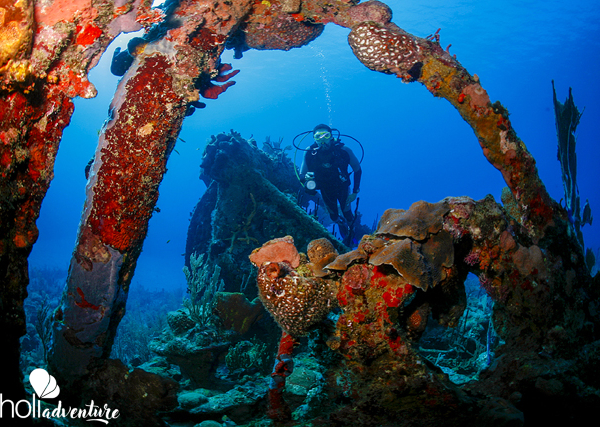General Information
- Category: Half day tours
- Modality: Nautical tours
- Duration: 2 hrs
- Departure time: 09.00 hrs
- Tour guide: Yes
- Children are allowed: No
- Languages spoken: English
Program Details
Scuba Diving in Wrecks of the Hispanic - Cuban and North American War of 1898. "DESTROYER FUROR".
Archaeological Park of the Natural and Cultural Underwater Heritage Battle of Santiago de Cuba Declared a National Monument in 2015.
General Description
The "Archaeological Park of the Natural and Cultural Underwater Heritage Battle of Santiago de Cuba" occupies a coastal strip of about 120 kilometers in length and was witness to the unequal combat between the squadrons of the Spanish Rear Admiral Pascual Cervera and the American Rear Admiral William Sampson, in which all the Spanish ships were annihilated ending the Spanish colonial rule in America, and giving way to the emergence of the most powerful empire in the history of mankind, the United States of America. The place is formed by seven archaeological sites (Las Cuatro Bocas Playa Siboney, Rancho Cruz - Buey Cabón, Playa Mar Verde, Ensenada de Juan González, Aserradero and Playa La Mula), whose environmental and archaeological characteristics are different from one site to another along the southeastern coastal strip of the province of Santiago de Cuba.
The vestiges of that naval crusade make up what is currently known as the "Batalla Naval de Santiago de Cuba" Underwater Archaeological Park. In this site lie the wrecks linked to the landing and the naval conflict, as well as all those material evidences belonging to the ships that are related in one way or another to the events, such as: masts, masts, remains of the rigging of the mastheads, ironwork, parts of the artillery sites, thick and medium caliber projectiles, flushes, balusters and mechanisms of the propulsion system.
It is a true privilege to learn about history through these wrecks, exceptional witnesses to the events of the Naval War of 1898, and to enjoy diving today in an environment of spectacular beauty, where the Sierra Maestra mountain range bursts into the Caribbean in an abrupt and irregular manner, cut by canyons and riverbeds and estuaries that extend into deltas covered with pebbles and low areas, forming wetlands covered with mangroves in the shelter of virgin inlets and coves: ecosystems that support incredible biological diversity.
ARCHAEOLOGICAL SITE: "MAR VERDE BEACH". Shipwreck: "Furor" destroyer
- The remains of the Torpedo "Furor" are located at 19 ° 57,644 N and 75 ° 56,556 W, at a distance of 540 meters from the coast, south of the west shore of the Mar Verde beach. At a depth of 22 meters, near a ridge that extends into an isobath between 23 and 27 meters.
- Location: Mar Verde town, west of the city of Santiago de Cuba.
Historical Background:
- The "Furor" Destroyer is part of a series of 6 Furor class ships, destroyer type, built in the Clydebank Engineering & Shipbuilding Co. shipyard in the United Kingdom and that have the same technical characteristics.
The Navy commissioned the captain of the ship Fernando de Villamil to design a new counter-torpedo ship, which would be included in the category of destroyers, as indicated by the then Minister of the Navy, Admiral Berenguer, to form part of the "First Squadron" of the Spanish Navy, commanded by Vice Admiral Pascual Cervera y Topete.
This ship, would serve as an escort to larger ships to protect them from enemy torpedo boats, since given its navigation characteristics as their main weapon. They were very powerful and fast, reaching a speed of 28 knots, which allowed them to pursue and hunt any torpedo boat of the time.
In spite of being such a sophisticated attack weapon for their time because they had strong weapons, capable of destroying any enemy torpedo boat, they had the Achilles' heel in their armor, because even though their hulls were made of steel, any impact of a medium caliber could completely eliminate them from the battle as it happened in the naval battle carried out in Santiago de Cuba.
TECHNICAL CHARACTERISTICS OF THE BOAT "Furor":
- Name of the shipwreck: "Furor".
- Shipyard: Clydebank Engineering & Shipbuilding Co., United Kingdom.
- Launch date: April 1897, completed 21 November 1896.
- Class: Furor.
- Ship type: destroyers.
- Flag: Spain.
- Date of entry into service: 21 February 1896.
- Commander: Captain of the ship "Fernando Villaamil Fernández-Cueto" - (1845-1898)
- Crew members: 65 men.
- Maximum speed: 28 knots.
- Range at low power: 1000 miles (nautical).
- Length: 69.79 metres.
- Beam: 6.80 metres.
- Strut: 4.20 metres.
- Draft: 3.00 meters.
- Displacement: 380 tons.
- Decks: Running, with a small bridge about 15 m from the bow, with wind turbines distributed along its length, with two 75 mm "Nordenfelt" cannons at the bow and at the stern in rotating axial trusses. Two davits on both sides in the first third of the boat. Handrails of cables along the whole row, from bow to stern, wooded with pipes screwed to the deck.
- Rudder: stern, spade out of the transom with shaft leading to the deck, driven by a servo motor.
- Shielding: No.
- Shielding: No, unarmoured steel decks.
- Barbets: no.
- Power: 4000 - 7000 hp with forced draft.
- Boilers: 4 "Normand" boilers.
- Type of machinery: 2 triple expansion steam engines.
- Type of feeding: Mineral coal - 96 tons.
- Propulsion: 2 propellers
- Masts: 1 mast with davit at a height of 30 m from the stem in its bay.
- Torpedo launchers: 2 locations (on deck)
- Large calibre artillery: 2 pieces.
- Maxims machine guns: 2 pieces.
Diving services included:.
- Basic diving equipment, compressed air tank and lead belt.
- Assistance of an instructor guide with international certificate, who will carry out an informative session of the immersion to be done.
- Boat that takes you from the diving center to the diving points (in principle, the dives that leave from the marina of Punta Gorda will be done by diving boat).
Marlin Punta Gorda Dive Center
- Output capacity in 10 Pax.
- Frequency: 2 daily departures.
Distance to be covered on the route (round trip): 30 km approximately.
Degree of difficulty: Low.
Approximate duration of the tour (total): 1.30 hours approximately.
Very important note: It is compulsory for customers to present their official diving certification.
Very important note: For reasons of safety and protection of underwater heritage, customers should never directly touch the wreck and must strictly follow the instructions given by the diving instructors.
TIPS: • Recommended: light clothing, swimsuit, towels, sunglasses, hat, sunscreen and photographic camera. • We recommend that the client can bring their own diving mask. • The client can bring his complete diving equipment if he wants to. • We recommend that the client can bring his/her personal dive computer. • We recommend that the client can bring one or more bottles of mineral water to stay hydrated as well as light foods rich in protein or fruit.
- The boat is shared.
- No minimum number of divers is required for the excursion. Holiadventure will reconfirm 48 hours before the departure of your tour. If the provider decides to cancel, for not meeting the minimum required amount of passengers, Holiadventure will offer an alternative tour or fully refund cost of your trip.
- Transportation not included in the services of the diving excursions in Santiago de Cuba. The client must arrive at the Marina Marlín in Punta Gorda by his own means 30 minutes before the indicated time of the excursion.
- The excursion can be cancelled in an unexpected way if the general weather conditions and especially in the sea advise it. This does not imply any responsibility or penalty for the agency and the marina company offering the service. In principle we will try to change the date of the excursion for the following days when the conditions improve. If this is not possible, we will proceed to refund the total value of the excursion paid by the client previously.
- The client must present a valid diving certificate issued by an internationally recognized diving organization.
- The client must sign a waiver of responsibility for diving as a risky activity, releasing the agency and the marine company offering the service from any legal responsibility, before leaving for the excursion.













